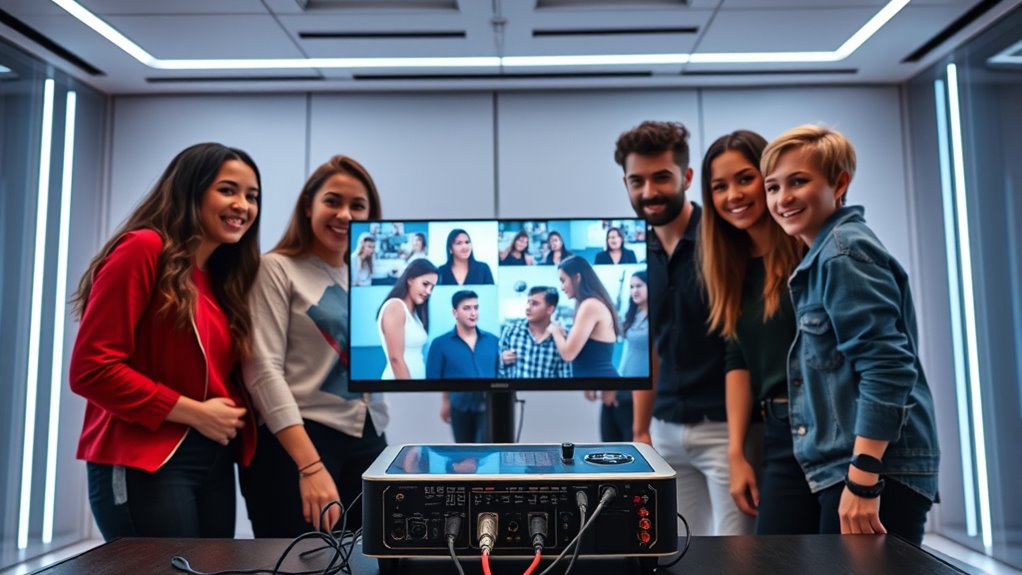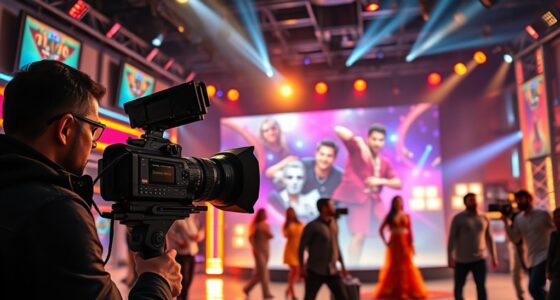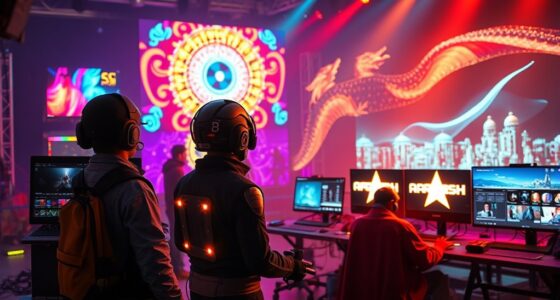This startup’s tech is set to eliminate lip-sync fails forever! By harnessing AI and machine learning, it guarantees that mouth movements align perfectly with audio in real-time. With advancements like audio-conditioned latent diffusion models and temporal representation alignment, the syncing process is now streamlined and precise. Plus, AI tools enhance accuracy and reduce the need for human dubbing. Curious about how this all works? There’s so much more to discover!
Key Takeaways
- The startup utilizes audio-conditioned latent diffusion models to achieve precise audio-visual synchronization for lip syncing.
- Their end-to-end framework streamlines the lip sync process, enhancing efficiency and accuracy.
- Temporal Representation Alignment (TREPA) ensures improved temporal consistency in lip movements across video.
- Open-source tools provide creators with support and resources to implement high-quality lip sync technology.
- Advanced algorithms analyze lip movements, overcoming challenges in noisy environments and individual variability for enhanced performance.
The Science Behind Lip Sync Technology

As you immerse yourself in the world of lip sync technology, you’ll find that it combines advanced disciplines like AI, machine learning, and computer vision to create realistic mouth movements synchronized with audio. This technology enhances video authenticity, making it widely used in film, animation, video games, and marketing. By leveraging deep learning models, like LSTM and GAN-based approaches, it generates real-time lip sync for animations with low latency. You’ll also discover how data augmentation techniques, such as audio time warping, improve training efficiency. While obtaining labeled data can be a challenge, AI tools are stepping in to streamline the process. This innovation not only engages viewers but also empowers creators by enabling faster localization and reducing reliance on human dubbing specialists, ultimately enhancing the quality of live 2-D animation.
How Latentsync Is Revolutionizing Video Lip Sync
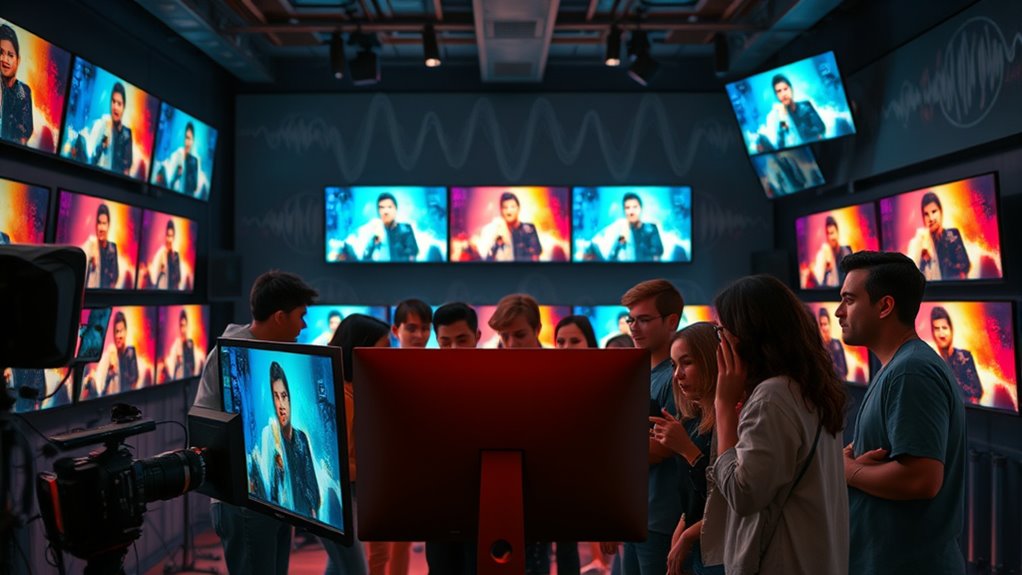
LatentSync is transforming video lip sync by introducing a groundbreaking end-to-end framework that streamlines the entire process. It uses audio-conditioned latent diffusion models, allowing for precise audio-visual synchronization without needing intermediate representations. By incorporating Temporal Representation Alignment (TREPA), it enhances temporal consistency, addressing common frame jittering issues. The system leverages Stable Diffusion for high-quality video generation, making it suitable for various applications like film dubbing and educational content. With its low resource requirements, you can achieve dynamic, realistic lip sync easily. Additionally, it excels at automatic lip sync generation, ensuring that the mouth movements align perfectly with the spoken audio. Plus, being open-source means you have access to tools and community support, empowering creators to revolutionize their video content without extensive manual editing.
The Role of Lip Reading Algorithms in Enhancing Accuracy
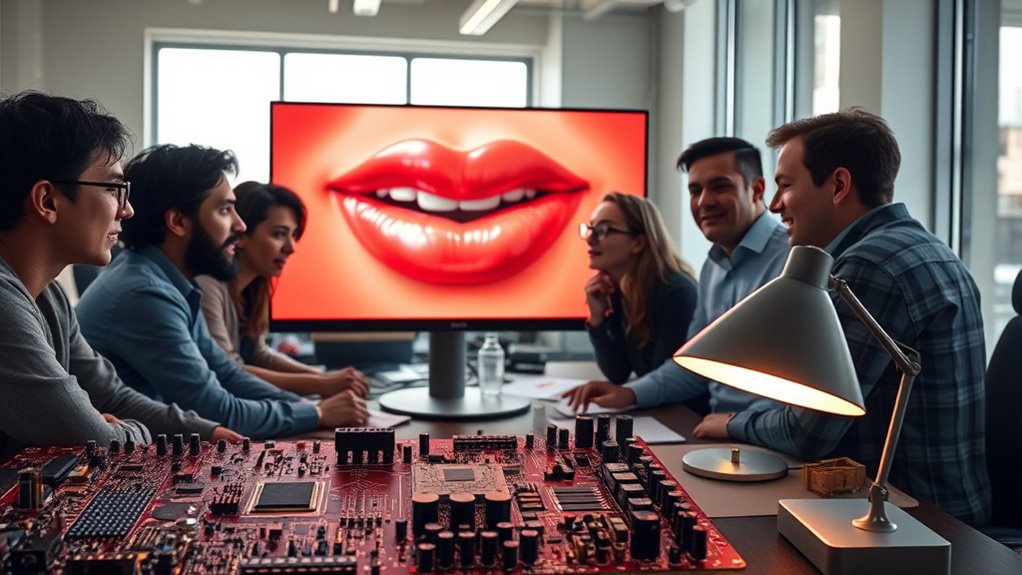
Video lip sync technology is advancing rapidly, and lip reading algorithms play a pivotal role in enhancing accuracy. By utilizing deep learning models, these algorithms analyze visual cues from lip movements, often surpassing human lip readers.
High-performance GPUs, like Tesla K80 and TITAN X, make it possible to train these models efficiently using large datasets from BBC programs. The algorithms excel in noisy environments, improving speech recognition by providing visual context.
However, challenges remain, such as distinguishing similar lip shapes and accounting for individual variability. Recent advancements, including Efficient-GhostNet and Gated Recurrent Units, further boost performance.
As these technologies evolve, they’ll greatly enhance video experiences and assist those with hearing impairments. Additionally, researchers at the University of East Anglia have developed a lip-reading algorithm that surpasses human accuracy.
Avatar Lip Sync: Bridging the Gap Between Reality and Virtuality
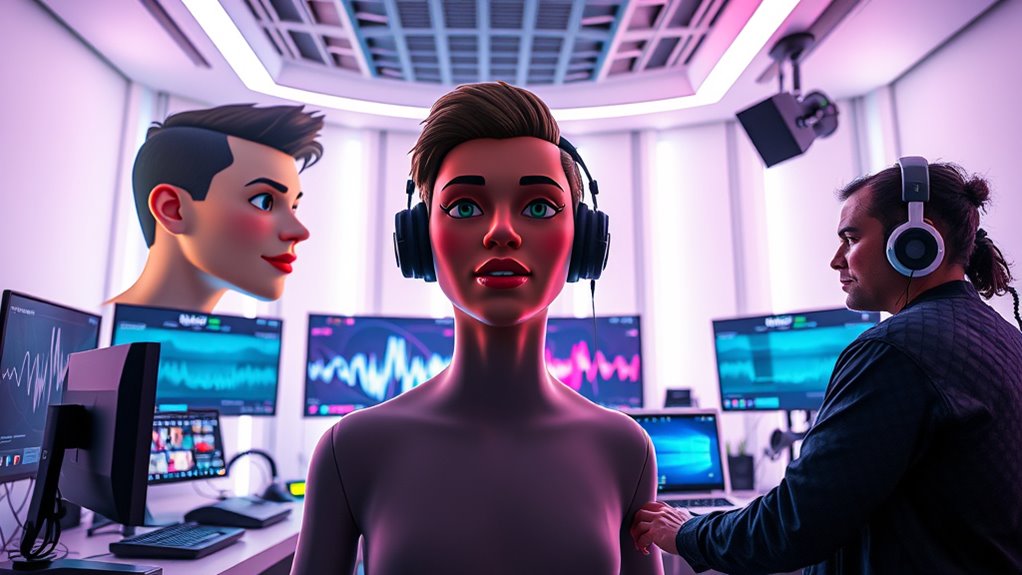
While technology continues to blur the lines between reality and virtuality, avatar lip sync is emerging as a key component in this transformation.
You’ll find that AI and machine learning refine this process, ensuring real-time accuracy in lip synchronization and emotional expression. Voice technology is pivotal in creating immersive experiences that enhance user interaction. As the demand for personalized experiences in various sectors grows, the technology behind avatar lip sync will become increasingly important.
Deepfake technology and Generative Adversarial Networks analyze human voice and facial movements, creating lifelike avatars.
Text-to-speech systems convert text into natural speech, enhancing emotional context.
Facial recognition and biometric data personalize avatars to mimic human behavior.
Applications span film, video games, and virtual reality, where avatars respond dynamically to user inputs.
As avatar lip sync evolves, it’s set to revolutionize interactions across various platforms, making virtual experiences feel increasingly real.
Overcoming Commercialization Challenges in Lip Sync Innovations

As businesses look to harness the potential of lip sync innovations, they face several commercialization challenges that could impede progress.
First, integrating AI for accurate mouth movements is complex, and real-time capabilities are still limited. Additionally, while AI reduces costs and enhances scalability, ensuring resource efficiency is vital. By utilizing AI tools that automate dubbing and lip sync processes, companies can improve both speed and accuracy in their content creation. The integration of intelligent tutoring systems could also provide valuable insights into user engagement and preferences.
Integrating AI for precise mouth movements remains complex, with real-time capabilities still developing and resource efficiency crucial for success.
Companies must navigate fierce market competition, where quality localized content can enhance customer engagement and trust. Ethical concerns, such as deepfake risks and cultural sensitivity, also demand careful attention.
Finally, compliance with data protection regulations is essential. By addressing these challenges head-on, you can leverage AI lip sync technology to create immersive experiences that resonate with global audiences and elevate your brand.
Frequently Asked Questions
How Can Lip Sync Technology Benefit People With Hearing Impairments?
Lip sync technology can greatly benefit you if you have hearing impairments. It enhances speech recognition by providing visual cues that complement what you hear, especially in noisy environments.
This boosts your confidence in communication and makes interactions more accessible, whether in person or online.
Additionally, it can support speech therapy by offering clear visual articulation cues, helping you improve your language skills and emotional understanding, ultimately fostering social connections.
What Industries Can Benefit Most From Improved Lip Sync Technology?
You mightn’t realize how much improved lip sync technology can transform various industries.
The film and entertainment sector thrives on enhanced realism, while education benefits from better comprehension and engagement.
Marketing sees increased trust and personalized content, and corporate communications achieve effective global messaging.
Are There Ethical Concerns Associated With Advanced Lip Sync Technology?
Yes, there are significant ethical concerns associated with advanced lip sync technology.
You should consider issues like consent, as using someone’s likeness without permission raises moral questions. Misinformation can spread easily through deepfakes, undermining public trust.
Additionally, intellectual property rights may be violated, necessitating clear regulations to protect individuals.
Educating yourself and others about these risks is essential to navigate the potential misuse and foster responsible use of this technology.
How Does Lip Sync Technology Impact User Experience in Virtual Reality?
Lip sync technology greatly shapes your virtual reality experience, enhancing engagement and immersion. When you see characters’ lips move accurately with their speech, it feels more authentic and relatable.
This synchronization allows you to focus on the narrative without distractions from mismatched movements. Additionally, improved communication quality enables emotional connections, making interactions more impactful.
What Future Trends Can We Expect in Lip Sync Technology Development?
You can expect future trends in lip sync technology to focus on advanced generative models and real-time processing.
These improvements will enhance accuracy across languages, making content more accessible. As deep learning algorithms evolve, they’ll better capture dialect nuances.
You’ll also see integration with virtual reality, creating immersive experiences.
However, challenges like complex video scenarios and the need for human refinement will persist, driving continuous innovation in the field.
Conclusion
In a world where mismatched lips and audio often steal the spotlight, Latentsync’s technology is like a skilled conductor ensuring every note hits perfectly. Imagine watching your favorite movie with characters that finally match their dialogue, immersing you in a seamless experience. By harnessing advanced lip reading algorithms and avatar innovations, this startup is not just fixing lip sync fails; it’s creating a new symphony of communication that bridges reality and virtuality, transforming how we engage with digital content forever.
